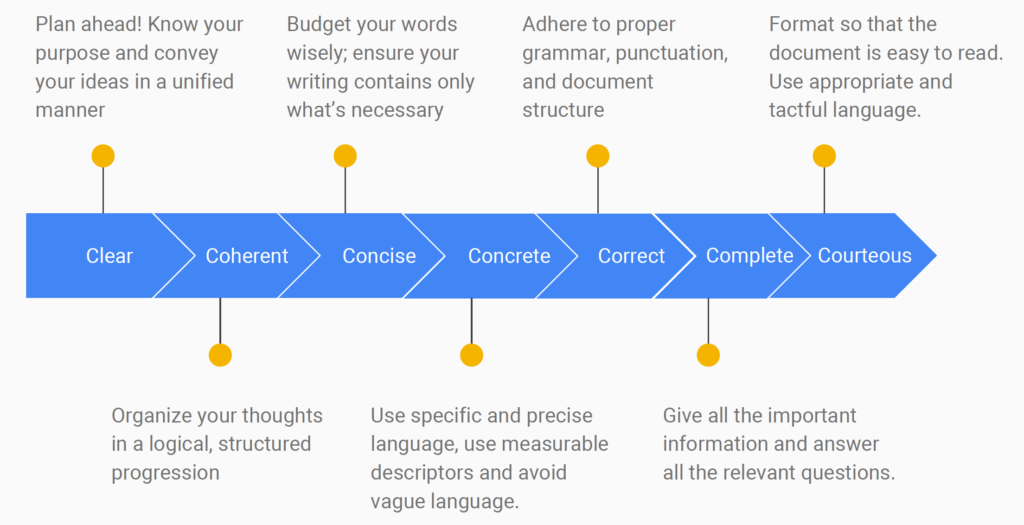8.1 Communicating with Precision
Two key characteristics of professional technical communication are that it is precise and concise. This precision and conciseness must be evident at all levels, from the overall document, to paragraphing, to sentence structure to word choice, and even to punctuation. Every word or phrase should have a distinct and useful purpose. If it doesn’t, cut it or revise.
The 7 Cs of Professional Writing
The 7 C’s are simply seven words that begin with C and characterize strong professional style. Applying the 7 C’s of professional communication will result in writing that is:
-
-
- Clear
- Coherent
- Concise
- Concrete
- Correct
- Complete
- Courteous
-
CLEAR writing involves knowing what you want to say before you say it because often a lack of clarity comes from unclear thinking or poor planning; this, unfortunately, leads to confused or annoyed readers. Clear writing conveys the purpose of the document immediately to the reader; it matches vocabulary to the audience, avoiding jargon and unnecessary technical or obscure language while at the same time being precise. In clarifying your ideas, ensure that each sentence conveys one idea, and that each paragraph thoroughly develops one unified concept.
COHERENT writing ensures that the reader can easily follow your ideas and your train of thought. One idea should lead logically into the next through the use of transitional words and phrases, structural markers, planned repetition, sentences with clear subjects, headings that are clear, and effective and parallel lists. Writing that lacks coherence often sounds “choppy” and ideas seem disconnected or incomplete. Coherently connecting ideas is like building bridges between islands of thought so the reader can easily move from one idea to the next.
CONCISE writing uses the least words possible to convey the most meaning while still maintaining clarity. Avoid unnecessary padding, awkward phrasing, overuse of “to be” forms (is, are, was, were, am, be, being), long preposition strings, vagueness, unnecessary repetition and redundancy. Use active verbs whenever possible, and take the time to choose a single word rather than a long phrase or cliched expression. Think of your word count like a budget; be cost effective by making sure every word you choose does effective work for you. Cut a word, save a buck! As William Zinsser asserts, “the secret of good writing is to strip every sentence to its cleanest components” (source link).
CONCRETE writing involves using specific, precise language to paint a picture for your readers so that they can more easily understand your ideas. If you have to explain an abstract concept or idea, try to use examples, analogies, and precise language to illustrate it. Use measurable descriptors whenever possible; avoid vague terms like “big” or “good.” Try to get your readers to “see” your ideas by using specific terms and descriptions.
CORRECT writing uses standard English punctuation, sentence structure, usage, and grammar. Being correct also means providing accurate information, as well as using the right document type and form for the task.
COMPLETE writing includes all requested information and answers all relevant questions. The more concrete and specific you are, the more likely your document will be complete as well. Review your checklist of specifications before submitting your document to its intended reader.
COURTEOUS writing entails designing a reader-friendly, easy-to-read document; using tactful language and appropriate modes of addressing the audience; and avoiding potentially offensive terminology, usage, and tone. As we have discussed in an early section, without courtesy you cannot be constructive.
Figure 8.1 illustrates one method of putting all the 7Cs together:

Always give priority to being clear: writing that lacks clarity cannot be understood and therefore cannot achieve its purpose. Writing that adheres to the 7 Cs helps to establish your credibility as a technical professional.
Additional Resources
- “Technical Writing Style.” Wikiversity
- “Professional Style.” Technical Writing Essentials
*This page borrows from the following source: "Communicating with Precision." Technical Writing Essentials. Source link.

